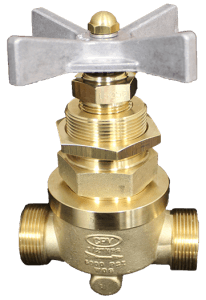The Preferred Choice for Oxygen Service
Naval Brass – Not for Naval Use Only
If naval brass sounds like something that’s meant to be used in the ocean, it’s because that’s exactly what it was designed for. Naval brass is a copper alloy containing zinc – about one percent tin and just a hint of lead in addition to the copper. Fortunately, its use is not restricted to just the sea.
Though copper by itself is useful for many applications, the addition of zinc boosts its strength. Brass with more than 39 percent zinc (like naval brass) has higher strength but lower ductility than that with less zinc.
The addition of a little tin increases brass’s corrosion and dezincification (the leaching of zinc) resistance. And though it is a minute amount, the lead boosts the material’s machinability.
Naval brass falls under the alpha-beta brass (or duplex brass) classification and is harder and stronger than other classes of brass.
 Oxygen Valves
Oxygen Valves
You may wonder then if naval brass was designed for marine use, why on Earth do we use it for oxygen service?
To answer this question, we need to talk about oxygen for a minute.
Oxygen is an oxidizing agent. An oxidizer itself is not combustible. But combine it with a flammable substance and a source of ignition, and you have a major fire hazard. That ignition source does not have to be a spark or flame. At the right pressure, heat has the potential to ignite combustible materials.
On top of that, when moisture is added to oxygen in the presence of iron (or iron-containing materials), a chemical reaction occurs. The oxygen and moisture corrode the iron, forming iron oxide (more commonly known as rust). Rust does more than just look bad. Rust corrosion, like any other form of corrosion, weakens the metal.
So when outfitting an oxygen-rich system with valves, it is important to address both of these properties of oxygen in the valve material selection.
- Materials that are susceptible to oxidation or corrosion need to be avoided.
- The materials used should be those least likely to catch fire.
Naval Brass Fits the Bill
Low Fire Risk
Most valve materials will not ignite at gaseous oxygen’s normal temperature. Where the risk comes in is with the chance of localized hot spots. High localized temperatures can result from sources such as vibration, foreign particles or debris, adiabatic compression, or static electricity.
Even a high flow velocity can result in heat from friction. In fact, if there is a chance that the velocity through the valve will pass 200 feet per second, the Compressed Gas Association (Pamphlet G-4.4) allows only copper alloys to be used as the valve body and any parts that contact gaseous oxygen.
Of all the metal options, copper alloys are the most effective for resisting ignition and have the slowest combustion rate. For that reason, naval brass ranks at the top of the list for fire and explosion safety purposes.
Corrosion Resistant
Corrosion and leakage are not wanted in any system. In an application such as oxygen service, corroded and leaking valves are dangerous. For safety and fiscal reasons, oxygen valves must be corrosion resistant and leak-free.
Again naval brass‘s corrosion resistance means it is a preferred choice for use in oxygen service.
Summary
It’s crucial that the right products be chosen for oxygen applications and that all are handled with care. That includes proper cleanliness. (Read about our class 10,000 cleanroom here.) We will work with you to ensure that you get the valves and fittings that fit your company’s needs.
Check out CPV Manufacturing’s line of O-SEAL® Naval Brass Oxygen Valves for your high pressure critical oxygen service needs or contact us for more information about how we can help you.

